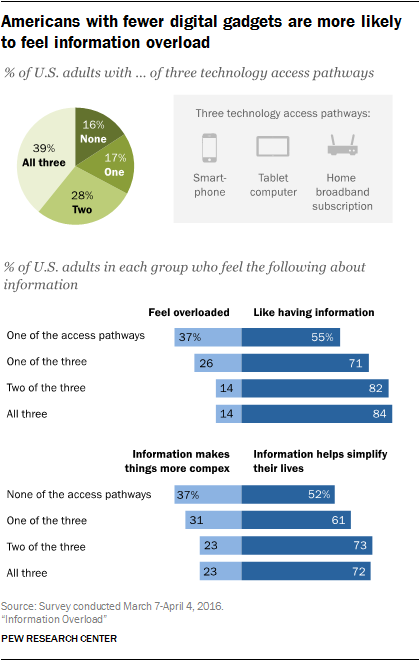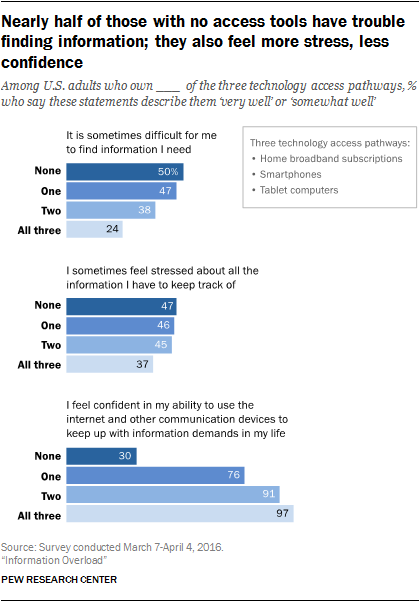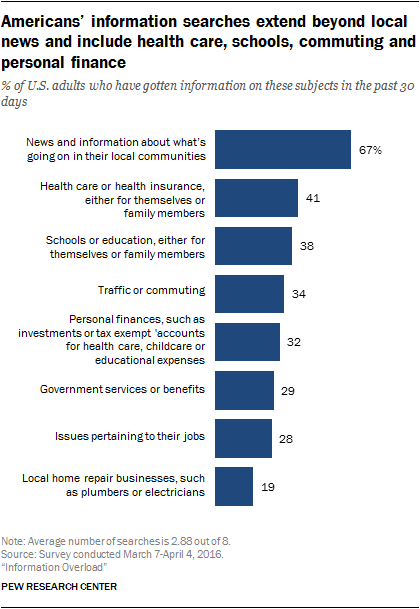
Those who have more pathways to access digital information express fewer concerns about information overload. The survey measured three key technological “access pathways” to information:
- 70% of U.S. adults have home broadband subscriptions.
- 72% have smartphones.
- 48% have tablet computers.
Overall, 39% of adults have all three access pathways; 28% have two of the three; 17% have one of the three; and 16% have none of them.
The key finding is that, perhaps contrary to conventional wisdom, it is those with more ways to access the internet that report being less overwhelmed by the amount of possible information in the modern technological world. Overall, 84% of those with all three access pathways say they like having so much information available, compared with 55% of those who have none of the three access pathways.

At the same time, those with fewer gadgets are more likely than others to say that information makes their lives more complex. Those with none of the three access pathways are significantly more likely than those with relative access abundance to feel information overload – by a 37% to 14% margin. The survey did not establish why this might be so, but one possible explanation is that people who are not comfortable with technology, and don’t have a lot of technology options, also know there is a modern world of digital information available to those who are proficient with digital tools. They might suspect that it could take more effort on their part to get the information they need than it would take people who have lots of digital access.
Similarly, when asked to consider whether information simplifies their lives or makes it more complex, half of those with none of the three access tools (52%) say information helps simplify their lives. For those with either two or three access tools, more than seven-in-ten say information helps to simplify their lives.
Those with fewer online access pathways are also more likely to report issues over managing the flow information in their lives. Among Americans with no digital access paths, 47% say they feel stressed about the information they have to follow. And half (50%) say they sometimes have difficulty finding the information they need. Those with no internet access devices are far less confident in their abilities to use internet-connected devices to keep up with information demands than those with one or more gadgets.
And the flip side is true, too: Those with more gadgets pursue more kinds of information

Beyond questions about information overload and the stresses that might be associated with it, the survey also explored the information needs and yearnings of Americans. We asked people if, in the prior 30 days, they had searched for information about eight different topics. Note that the question was framed about searching for information and did not cast the query in terms of tools people might use to gather information, such as the internet, print media, other people or libraries.
Some of the findings: 67% of adults said in the past month they had gotten information about what’s going in their communities; 41% got some kind of health-related information; 38% got material about schools or education; and 28% got information pertaining to their jobs. The nearby chart covers all eight of the subjects queried.

The differences in the incidence of information searching are stark when comparing those with “access abundance” (that is, each of the three pathways) to those with “access scarcity” (those with none of the access tools). In most cases, those with access abundance were substantially more likely to have done each of these searches than those with access scarcity. For instance, 76% of those with all three access pathways had searched for community news and information in the past month, compared with 48% of those with none of the pathways. Those with access abundance were three times more likely to seek information about schools or education as those without any of the access paths, and they were four times more likely to have searched for information about traffic and commuting and personal finances.
We are not able to determine causality here – that is, whether the availability of more access pathways makes people search for more information or vice versa. Some people may purchase more tech gadgets because they have high levels of demand for information or desire lots of information – and, thus, they show higher incidence of information searching.At the same time, the availability of tech gadgets may also draw people to satisfying their information needs by using those resources. The size of the differences are such that it is likely that some of both is going on, i.e., those with high information demands buy more gadgets and the availability of information tools and information institutions stimulates the frequency of information searching. In any case, these associations are significant when holding other socio-economic and demographic factors constant.1




